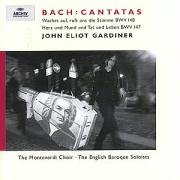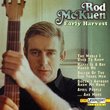| All Artists: Johann Sebastian Bach, John Eliot Gardiner, The English Baroque Soloists, Anthony Rolfe Johnson, Ruth Holton, Stephen Varcoe, The Monteverdi Choir Title: Bach - Cantatas BWV 140, 147 / Holton, Chance, Rolfe Johnson, Varcoe, The Monteverdi Choir, The English Baroque Soloists, Gardiner Members Wishing: 0 Total Copies: 0 Label: Archiv Produktion Release Date: 10/10/2000 Genre: Classical Styles: Opera & Classical Vocal, Historical Periods, Baroque (c.1600-1750) Number of Discs: 1 SwapaCD Credits: 1 UPC: 028946358726 |
Search - Johann Sebastian Bach, John Eliot Gardiner, The English Baroque Soloists :: Bach - Cantatas BWV 140, 147 / Holton, Chance, Rolfe Johnson, Varcoe, The Monteverdi Choir, The English Baroque Soloists, Gardiner
CD DetailsSimilarly Requested CDs |
CD ReviewsExcellent Bogdan Minut | Columbus, IN United States | 03/26/2002 (5 out of 5 stars) "Issued in the year 2000, this compact disc was a small contribution to the promotion of the Monteverdi Choir cantata tour. Together with the English Baroque Soloists, they performed all the surviving church cantatas by Johann Sebastian Bach during the course of 2000, on the liturgical days for which they were composed, in different churches around Europe and US. Gardiner talks a little about this endeavor in the line notes: "Bach is probably the only composer whose musical output is so rich, so challenging to the performer and so spiritually uplifting to performer and listener alike, that one would gladly spend a year in his exclusive company." In 1731, based on a hymn by Philipp Nicolai, Wachet auf, ruft uns die Stimme, Bach wrote a chorale cantata with the same title. The text is based on the parable of the ten virgins in the prescribed Gospel reading, Matthew 25: 1-13. Of the seven sections, the first and the last as well as the middle fourth are chorales. Interestingly enough, the middle one, Zion hört die Wächter singen, is for tenors and orchestra. Furthermore, the intermediate pairs of sections are similar in the way that each of the groups begins with a recitative and ends with an Aria/Duet for soprano and bass soli. The duets represent the conversation between Jesus (bass) and the Soul (soprano), while the middle chorale is the song of the watchmen from the Song of Songs. Initially composed in 1716 for a service in the Weimar chapel on the fourth Sunday in Advent, Cantata BWV 147 was revised by the composer in 1723 for the Feast of the Visitation of the Blessed Virgin Mary. Divided into two parts, sung before and after the sermon, this cantata uses five of Salomo Frank's original verses to which Bach added recitative texts in order to make the text more relevant to the Feast. The text takes Mary's words as the paradigm for personal Christian proclamation and encourages the congregation to bear witness to Christ freely with "heart and lips, thy whole behavior" (Herz und Mund und Tat und Leben). The final chorale is the famous Jesus bleibet meine Freude, a reiteration of the one ending the first part, Wohl mir, dass ich Jesum habe, later on transcribed for keyboard by Myra Hess as the extremely profound and noble Jesu, Joy of Man's Desiring. It's been said that the importance of Gardiner's performances consist of the use of authentic instruments and as a consequence the whole sonority changes mostly because of the lowered tuning (a'=415 Hz). However, the critics don't always remember the quality of the musicians who, at least in these versions of Bach's 140 and 147, are exceptional, from the soloists to the orchestra and chorus members. The tempi and the dynamics altogether with the phrasing and the musical expression are well determined by the musicians led by John Eliot Gardiner. We should remind the reader that those parameters were hardly notated in Bach's time, fact that has determined so much confusion in time. The bouncy articulation and the happiness of the singing or playing lines make this recording a fresh and even modern interpretation of these two masterpieces of the musical world. I left at the end a word about the cover presentation of this compact disc. The picture strikes the viewer with a contrasting black and white image of two different worlds, or if you wish, different eras. The present is the background, dark (night), on a city street, where the details are intentionally fuzzy suggesting maybe the diffuse life of contemporary people. However, in the center of the viewer's attention, the bright 1748 E.G. Haussmann painting of Bach on the case of a double bass reveals the clarity and serenity of a disappeared time. And it looks like we, the viewers (read the listeners), feel closer to that world because we can just "see" the stillness of the moving double bass." Solid and thorough performance bigmikedc | Sugar Hill, GA United States | 11/27/2000 (4 out of 5 stars) "Phew! I had a hard time finding this CD due to the fact that I recently - as of this review - bought the 1992 CD version when it was manufactured and marketed by PolyGram Classics. As I can see, the cover now for this 2000 version is totally new in terms of a cover and in terms of the new marketer which is now umm...UNI? Anyway, moving on to the actual music. Gardiner has this piece profoundly acurrate. I say this because it's on authentic instruments (which Gardiner seems to have an obsession with) and yet I still absolutely love this piece to death. Perhaps, this particular piece works in terms of using authentic instruments due to the fact that no tympani is required for it anywhere throughout these cantatas.I like to hear any piece involving heavy use of tympani to have thunder about it, which is where most "authentic" typmanis take their biggest hits. I believe thats where a modern tympani would be required to bring true thunder which I love to death. Since there's not much thunder in terms of pounding symphonic music here, it has to have something else that truly appeals right? Ok, I absolutely find beauty in the sheer eloquentness of this music. I find something incredible when the soloists are performing these pieces with such care and energy that you can not help but be transported back to the actual Baroque period. What else can one ask for other than cantatas that sound like cantatas and not like a conductor took the piece and shaped it totally different than what he believed the composer would have found acceptable. For those who know "Jesu, Joy of Man's Desiring" instead of it's German title, than you'll be happy to know that this is where it comes from. The choir are on par and above as is usually expected from the Monteverdi Choir and their sheer experience with Gardiner. The English Baroque Soloists are also quite up to task, I can find no real fault other than perhaps a slight recording prob that wasnt balanced out before the CD went to production. The BWV 140 is certainly not as loud overall as the BWV 147. Then again, maybe they fixed that with the new version for which you see here. Splendid music!" One small correction Harry W. Crosby | La Jolla, California United States | 03/13/2006 (4 out of 5 stars) "The Amazon listing for this disk shows a release date in 2000. Actually, this disk was originally released in 1992 and re-released in 2000. At least one of the guest reviewers also says it was recorded in 2000. I have the disk and consider it to be excellent, my only reservation being the recording itself which is not quite up to the technical quality of the Gardiner/Bach recordings actually made in 2000."
|


 Track Listings (17) - Disc #1
Track Listings (17) - Disc #1



